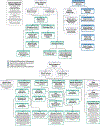Development and pre-pilot testing of STAMP + CBT: an mHealth app combining pain cognitive behavioral therapy and opioid support for patients with advanced cancer and pain
- PMID: 38252172
- PMCID: PMC11088794
- DOI: 10.1007/s00520-024-08307-7
Development and pre-pilot testing of STAMP + CBT: an mHealth app combining pain cognitive behavioral therapy and opioid support for patients with advanced cancer and pain
Abstract
Purpose: We developed and piloted a mobile health app to deliver cognitive behavioral therapy for pain (pain-CBT), remote symptom monitoring, and pharmacologic support for patients with pain from advanced cancer.
Methods: Using an iterative process of patient review and feedback, we developed the STAMP + CBT app. The app delivers brief daily lessons from pain-CBT and pain psychoeducation, adapted for advanced cancer. Daily surveys assess physical symptoms, psychological symptoms, opioid utilization and relief. Just-in-time adaptive interventions generate tailored psychoeducation in response. We then conducted a single-arm pilot feasibility study at two cancer centers. Patients with advanced cancer and chronic pain used the app for 2 or 4 weeks, rated its acceptability and provided feedback in semi-structured interviews. Feasibility and acceptability were defined as ≥ 70% of participants completing ≥ 50% of daily surveys, and ≥ 80% of acceptability items rated ≥ 4/5.
Results: Fifteen participants (female = 9; mean age = 50.3) tested the app. We exceeded our feasibility and accessibility benchmarks: 73% of patients completed ≥ 50% of daily surveys; 87% of acceptability items were rated ≥ 4/5. Participants valued the app's brevity, clarity, and salience, and found education on stress and pain to be most helpful. The app helped participants learn pain management strategies and decrease maladaptive thoughts. However, participants disliked the notification structure (single prompt with one snooze), which led to missed content.
Conclusion: The STAMP + CBT app was an acceptable and feasible method to deliver psychological/behavioral treatment with pharmacologic support for cancer pain. The app is being refined and will be tested in a larger randomized pilot study. TRN: NCT05403801 (05/06/2022).
Keywords: Cognitive behavioral therapy; Just-in-time adaptive intervention; Oncology; Opioids; Pain management; mHealth.
© 2024. The Author(s), under exclusive licence to Springer-Verlag GmbH Germany, part of Springer Nature.
Figures



References
Publication types
MeSH terms
Substances
Associated data
Grants and funding
LinkOut - more resources
Full Text Sources
Medical

